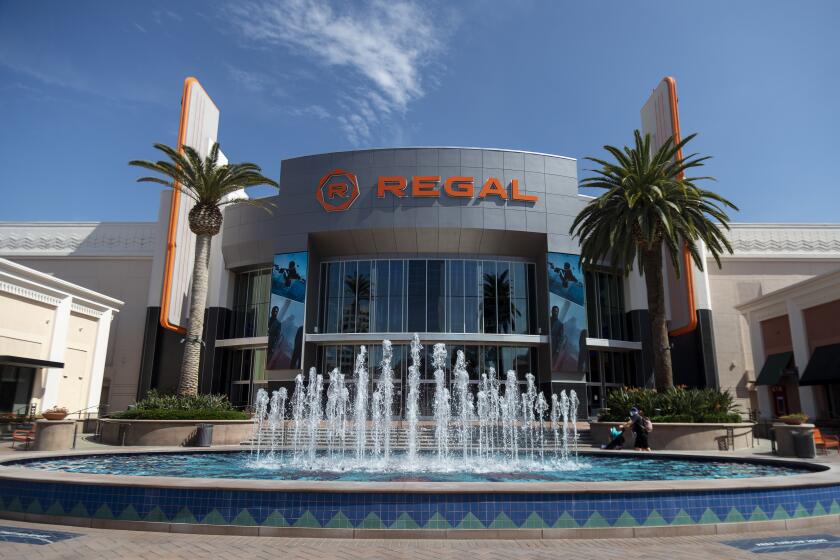How ‘Croods: A New Age’ previews what movie releases could look like after the pandemic
- Share via
In Universal Pictures’ animated sequel “The Croods: A New Age,” a prehistoric family of cave dwellers meets another clan that gives them a preview of mankind’s future.
Another evolutionary leap is happening in the movie industry.
With the Thanksgiving release of the $65-million DreamWorks Animation film, Hollywood will get a glimpse of what the business of releasing movies could look like after the COVID-19 pandemic. The film will be released Nov. 25 in the few U.S. theaters that remain open. Before Christmas, less than a month later, the family comedy will be available for households to rent digitally for $20.
“The Croods: A New Age,” the follow-up to DreamWorks’ 2013 hit “The Croods,” is the latest film to be released under a novel strategy Universal pushed forward during the public health crisis that dramatically shortens the gap between a movie’s theatrical debut and its home video availability.
Under terms of deals with two top cinema owners, Universal will have the option to release movies on home video after just 17 days in theaters. Before the coronavirus, studios waited at least 74 days before putting their films on iTunes or Amazon Prime. The average gap before home releases, known as the theatrical window, was about 90 days.
The pandemic shutdowns have given studios opportunities to experiment with new ways of releasing movies. But Universal executives say the Comcast-owned studio’s new $20 rental window — dubbed premium video on-demand, or PVOD — is not a temporary fix.
“This is our new normal,” said Peter Levinsohn, Universal Filmed Entertainment Group’s chief distribution officer. “We may make the decision that certain films should have more than three weekends at the box office, but our new normal is that we’re going to be making our films available in the home sometime after that third weekend.”
Theaters have long clung to the months-long exclusive theatrical window as a means of protecting their business model from at-home competition. If people know they can wait just three weeks to see new movies without going to theaters, they will, critics of the strategy say. Some analysts and industry insiders doubt that the added revenue of PVOD will make up for declines in box office.
“PVOD hasn’t exactly set the world on fire,” said Eric Handler, an MKM Partners analyst who covers theatrical exhibitors.
But resistance has begun to erode. Cinemark Theatres, the nation’s third-largest cinema chain, on Monday announced a multiyear deal to let Universal put most of its movies on video platforms after the film’s third weekend in release. Movies that open with more than $50 million in domestic box office, including “Fast & Furious” and “Jurassic World” franchise pictures, can go to home video after 31 days, or five weekends. The Cinemark deal followed a similar pact Universal reached with No. 1 chain AMC Theatres in July. The theater companies get a cut of the PVOD sales.
“This was not a decision that was made in the short term,” said Cinemark CEO Mark Zoradi, who previously criticized Universal’s 17-day windowing plan. “We felt like [Universal was] willing to comprise with dynamic windows, and we felt we needed to be willing to compromise as well.”
Cinema stocks were hammered after Regal owner Cineworld said it would re-close its locations this week.
For Universal, the deals mark a significant step toward keeping its movie business healthy in the face of threats from Netflix and other streamers, which are spending billions of dollars to produce and acquire films from top Hollywood talent.
The additional revenue from early rentals will make more movies profitable, allowing the studio to release more of its films in theaters, Universal executives said. Most movies collect 75% of their box office gross in the first three weekends of release. Meanwhile, the average American went to the movies fewer than four times in 2019, according to Motion Picture Assn. data.
Shorter windows also let studios get more bang for their marketing bucks. Under the old model, Universal would’ve spent tens of millions of dollars in advertising ahead of the theatrical debut of a movie like the new “Croods,” only to have to restart the campaign months later for home video.
“It was always kind of obvious that this was a good idea,” said Donna Langley, chairman of Universal Filmed Entertainment Group. “It took a pandemic to really demonstrate that the theatrical landscape was going to change irrevocably and that we really needed to partner with exhibition in order to create a business model that enabled studios and exhibition to continue doing what they’re doing.”
The more flexible model also preserves theatrical releases for filmmakers who want their films to appear on the big screen rather than going straight to streaming, executives said. If studios and theaters stick to long, inflexible release strategies, warned “Get Out” and “BlacKkKlansman” producer Jason Blum, moviegoers will see little at the multiplex other than superhero movies and other tent poles.
“If everyone sticks with a four-month window, every single movie that‘s not an event movie will be a streaming movie,” said Blum, whose Blumhouse Productions has a deal with Universal. “The question is: Would you rather have a three-week window or have everything go straight to streaming?”
For theaters, having more new movies on their screens is a matter of survival.
With Los Angeles and New York theaters still closed and cases rising across the country, studios have pushed big releases into 2021 and beyond.
Besides Universal, other studios are toying with new release plans or selling their movies to streaming services. Walt Disney Co. decided to send “Hamilton,” “Mulan” and “Soul” straight to Disney+. ViacomCBS’s Paramount Pictures has sold Eddie Murphy’s “Coming 2 America” and the Michael B. Jordan picture “Without Remorse” to Amazon.
AT&T Inc.’s Warner Bros. on Wednesday said it will put Patty Jenkins’ “Wonder Woman 1984” on HBO Max on Dec. 25, the same day it hits U.S. theaters. Warner Bros.’s Robert Zemeckis film “The Witches” previously went directly onto WarnerMedia’s HBO Max.
Without new films, theater chains including AMC face the possibility of bankruptcy. AMC Chief Executive Adam Aron, in a recent call with analysts, credited Universal for doing a deal that allowed it to keep putting movies in theaters.
Before the end of the year, Universal and specialty label Focus Features will release cross-cultural comedy “Half Brothers” (Dec. 4), romantic drama “All My Life” (Dec. 4), the Tom Hanks western “News of the World” (Dec. 25) and Emerald Fennell’s “Promising Young Woman” (Dec. 25) under the theatrical and video-on-demand strategy.
“The conversation that we’re having with every major studio is that AMC, as we proved with the Universal deal, is not stuck back in 1955,” Aron told analysts. AMC declined to comment for this story.
AMC’s embrace of PVOD was a rapid about-face.
Theater owners were incensed in March when Universal decided to release “Trolls World Tour” directly to PVOD on the same day as its planned theatrical release. After the “Trolls” sequel produced strong sales online, NBCUniversal CEO Jeff Shell told the Wall Street Journal the studio would release movies “on both formats” after theaters reopened. Aron responded with an open letter to Langley, declaring that the chain would no longer play Universal movies. By late July, AMC and Universal had a deal.
Cineworld, the British owner of the No. 2 U.S. theater chain Regal, which closed its U.S. locations again in October due to poor attendance, has not signed a deal with Universal. Cineworld CEO Mooky Greidinger in July said he didn’t “see any business sense” in Universal’s strategy. Cineworld representatives did not respond to requests for comment.
Exhibitor trade group the National Assn. of Theatre Owners, which for years spoke out against shrinking theatrical windows, also declined to comment.
Stephanie Hill, owner of the Premiere Theaters Oaks 10 in Melbourne, Fla., said the lack of new films has weighed heavily on attendance at her cinema, which has been open since June. Before the pandemic, her multiplex averaged roughly 1,000 visitors a day. Since reopening, attendance has shrunk to about 100 a day.
Hill said the early VOD windows may be here to stay. In that case, she wants industry groups such as the Independent Cinema Alliance to make sure small theater operators are included in revenue-sharing arrangements.
“The studios have been trying to reshape and shrink that model for years and years,” she said. “If this is going to be the new model moving forward, hopefully everyone can be included in that model, not just AMC, Regal and Cinemark.”
The strategy appears to be working for Universal. The first eight movies Universal released during the pandemic have all been profitable, studio executives said. Those include “The Invisible Man,” “Emma,” “The Hunt” and “Never Rarely Sometimes Always,” which were released in theaters and shifted to VOD when theaters shut. “Trolls World Tour,” “The High Note,” “The King of Staten Island” and “Irresistible” were released on PVOD after theaters closed. Studios including Universal have declined to release sales figures for video-on-demand releases.
“The economics of the movie business need this,” Levinsohn said. “More films will go to theaters if the profitability of that model is better than what you see today, where a lot of films are being sold off.”
More to Read
Inside the business of entertainment
The Wide Shot brings you news, analysis and insights on everything from streaming wars to production — and what it all means for the future.
You may occasionally receive promotional content from the Los Angeles Times.












